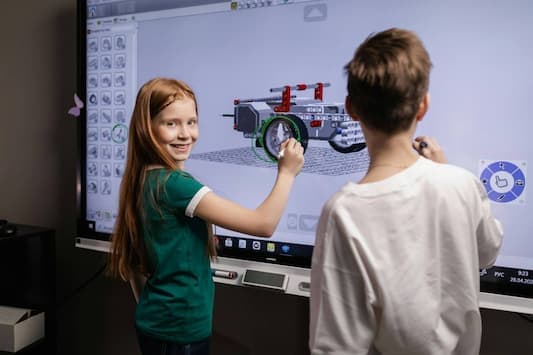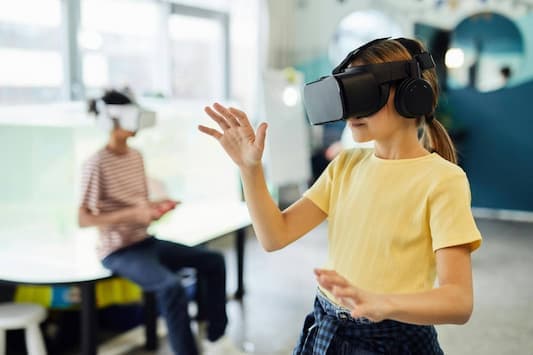Do you take your children to museums? They’re great places to learn. Some museums are extremely hands on for children, and they pay attention to each exhibit. Other times, when I take my kids to museums, I point out “look at this beautiful necklace” and they admire it, then run off down the hall until I point out another cool thing I saw.
Many museums are using 3D walkthrough animations to make museums more kid friendly and to help them learn. Here’s how.

There’s something magical about museums—centuries-old artifacts, untold stories, and windows into distant cultures. But for children, rows of glass cases and long information panels can sometimes feel a bit… static. It can be challenging for parents to keep young minds engaged as they wander through halls of historical treasures. That’s why more museums are turning to 3D walkthrough rendering services to bring exhibits to life, making learning interactive and truly immersive.
Imagine walking through an ancient Egyptian temple with your child, watching their eyes widen as towering statues and vast tombs come alive before them. Or exploring the International Space Station, floating weightlessly as your kids learn about the vastness of space. These are not just dreams but real possibilities thanks to 3D walkthrough animation service solutions. These cutting-edge tools allow museums to create interactive learning environments where curiosity thrives, and history unfolds in a way that both parents and children can understand and enjoy.
The Evolution of Museum Education for Kids
Let’s rewind a bit. Not long ago, the height of museum technology was a button that would light up a small section of a display or play a brief audio clip. Kids would press it, listen for a moment, and move on. Fast-forward to today: educational exhibits are fully interactive, visually rich, and even responsive to movement. The shift from static displays to animated walkthroughs is not just about flash—it’s about the connection.
For kids, this is a game-changer. A 3D architectural walkthrough service allows children to step inside places they’ve only read about in textbooks. Instead of just looking at a dinosaur model, they can watch it walk, breathe, and even hear it roar. Instead of reading about ancient cities, they can walk through bustling marketplaces, peek inside ancient homes, and interact with their surroundings.
It’s like a virtual playground for learning, where history isn’t just seen; it’s experienced. For parents, it’s an incredible opportunity to watch their children learn in real-time, asking questions and engaging with history and science in ways that would never happen with a dusty old textbook.
Benefits of 3D Walkthrough Animation Services in Museums for Families
So, why is 3D walkthrough animation so impactful, especially for families? Let’s break it down:
- Enhanced Engagement: Children are naturally drawn to animation and movement. They are no longer passive observers with interactive walkthroughs—they explore, make decisions, and learn by doing.
- Improved Accessibility: Not every family can travel to famous museums, but virtual walkthroughs open the doors to anyone with an internet connection. Kids in remote areas can “walk” through the Louvre or the Smithsonian without leaving their homes.
- Dynamic Storytelling: Want to show how medieval knights prepared for battle or how a Roman city bustled with life? 3D animations make these stories vivid and memorable for young minds.
- Flexible Learning: Every child learns differently. Some want to rush through exhibits; others want to linger and ask questions. Virtual walkthroughs allow kids to explore at their own pace.
For parents, museum visits are more than just a day out—they become interactive learning experiences that resonate long after they leave the building.

Real-Life Applications: Kid-Friendly Museum Adventures
Some of the world’s most iconic museums already embrace this technology to enhance children’s and families’ learning.
A virtual dinosaur walkthrough at the Smithsonian Institution lets young visitors explore a prehistoric landscape. Kids can watch how different species moved, interacted, and lived in their environments. The animations display educational facts as users navigate the area, turning a simple walk into an educational adventure. Since its launch, school group visits have skyrocketed, with teachers and parents praising its engaging format.
Across the Atlantic, the British Museum collaborated with a 3D architectural walkthrough company to reconstruct the Library of Ashurbanipal. Through digital animation, families can wander through the towering shelves and explore ancient texts as if they were standing right there. The experience improves children’s fact retention and deepens their emotional connection to the stories behind the artifacts.
These examples are more than just digital eye candy—they represent a shift in how museums engage young learners. They turn passive observation into active exploration, making history come alive in ways that stick with kids long after the visit ends.
Designing Kid-Friendly Interactive Learning Experiences
To make these 3D walkthrough animation services truly effective for families, museums need to consider a few critical elements:
- Start with Learning Objectives: Before the design begins, educators and curators should outline what kids should learn. Is it historical empathy? Understanding of scientific concepts? The goals will guide the design.
- Balance Fun with Education: It’s easy to get carried away with flashy graphics, but the real goal is learning. Every animation should serve an educational purpose, even if it’s cleverly disguised as fun.
- Test with Kids: There’s no better way to see if something works than to put it in children’s hands. Watch how they interact, where they get stuck, and what they enjoy.
By focusing on these principles, 3D architectural walkthrough service providers can create experiences that captivate kids while delivering real educational value.
Challenges and Considerations for Parents and Educators
Of course, no innovation is without its hurdles. Integrating 3D walkthrough animation services into museum spaces isn’t always smooth sailing. For one, costs can be a significant barrier. High-quality 3D content doesn’t come cheap, and not every institution has the budget for large-scale digital installations.
Additionally, museums must ensure that these high-tech experiences are accessible to all visitors, regardless of tech familiarity. Not every child is comfortable with virtual interfaces; some may need hands-on guidance. For parents, this can mean more involvement during the experience—but isn’t that part of the fun?
Lastly, while digital experiences are incredible, they should never overshadow the artifacts. The goal should always be to enhance learning, not replace it. For parents, it’s a reminder that while 3D walkthroughs are thrilling, touching a real fossil or seeing an actual piece of history still has unmatched magic.
Future Trends in Museum Interactivity for Families
The future of 3D walkthrough animation services in museums is bright. Imagine VR headsets that allow your child to walk alongside a woolly mammoth or AI-driven tours that adjust based on your child’s learning style. As your family walks through an exhibit, mobile-based AR could layer historical facts over real-life artifacts.
Some companies are experimenting with mixed-reality learning, where students worldwide can virtually visit the same museum space and learn together. This is a glimpse into what museum learning could be—a borderless, fully immersive educational experience.
Conclusion
For parents and children, museums are no longer just places to look and listen. With the help of 3D walkthrough animation services, they are becoming interactive playgrounds for the mind. Kids can walk with dinosaurs, explore ancient ruins, and dive deep into the mysteries of space—all without leaving the museum floor.
This technology is changing how children learn, and families experience history and science together. As more museums adopt these technologies, we can expect richer, more engaging experiences that inspire curiosity and foster lifelong learning.




